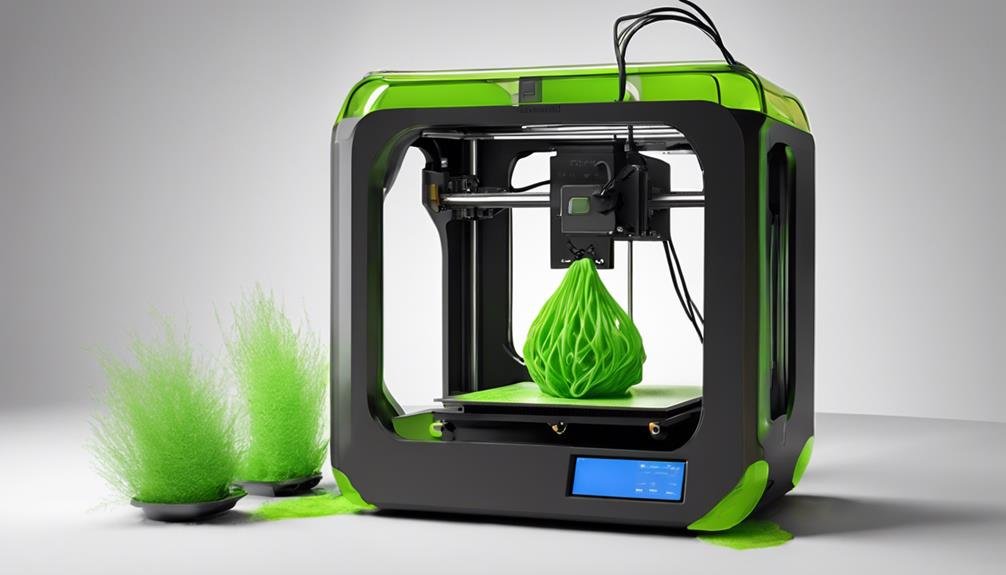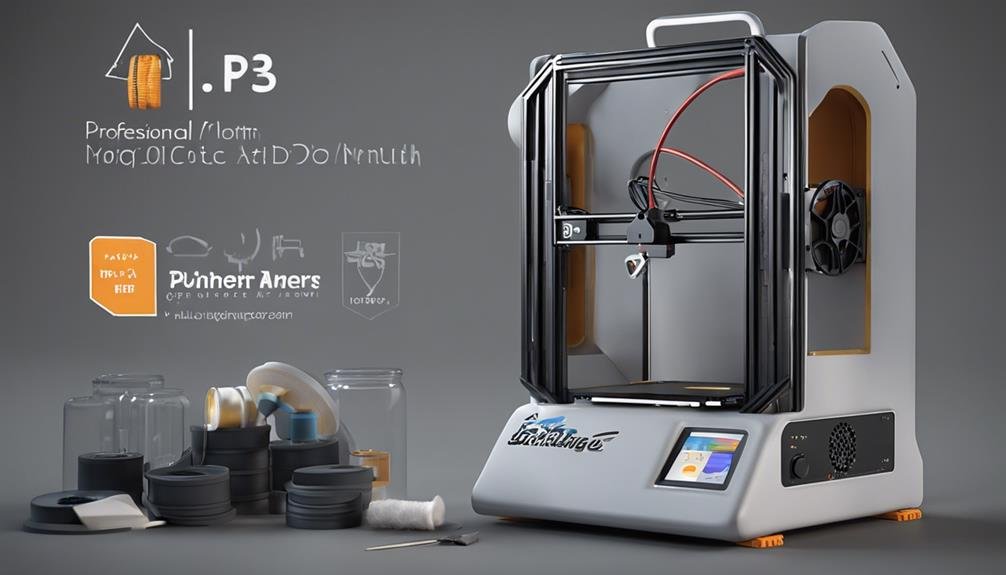3D printing is environmentally friendly due to its waste reduction, energy efficiency, localized production, and eco-friendly materials. Additive manufacturing creates objects layer by layer, minimizing waste compared to subtractive methods. Sustainable materials like recycled filaments and PLA reduce carbon footprints. The process uses less energy and innovations improve efficiency. By producing items closer to the point of use, transportation emissions are reduced. These aspects collectively contribute to its eco-conscious status. If you want to further investigate the environmental benefits and advancements of 3D printing, there is more to uncover about its sustainable practices.
Environmental Impact of 3D Printing
When considering the environmental impact of 3D printing, it becomes evident that this technology offers significant advantages in reducing waste and lowering carbon footprints. Additive manufacturing in 3D printing allows for the precise addition of materials layer by layer, minimizing excess material usage compared to traditional subtractive methods.
By utilizing sustainable materials such as recycled filaments and bio-based polymers, the carbon footprint of production is further reduced. Moreover, energy-efficient manufacturing processes in 3D printing contribute to decreasing CO2e emissions significantly.
Furthermore, the localized production aspect of 3D printing plays a vital role in environmental conservation by reducing transportation emissions and energy consumption associated with centralized manufacturing. Studies have shown a notable 24.8% decrease in CO2e emissions with the adoption of 3D printing technology.
Embracing this creative approach not only promotes sustainability but also demonstrates the potential for lower carbon footprints across different industries.
Waste Reduction in 3D Printing
Considering the waste reduction capabilities of 3D printing, it's clear that this technology greatly minimizes material usage and promotes sustainable practices. With additive manufacturing, 3D printing creates objects layer by layer, adding materials precisely where needed. This approach results in minimal waste production, as opposed to traditional subtractive manufacturing methods where excess material is often discarded.
Moreover, 3D printing enables the recycling and upcycling of printing materials, transforming waste into valuable resources for new products. By utilizing sustainable materials like recycled filaments and bio-based polymers, 3D printing contributes to eco-friendly practices and waste reduction.
In addition, the localized production aspect of 3D printing plays a significant role in reducing transportation emissions, further enhancing its environmentally friendly profile. Through its efficient use of resources and forward-thinking manufacturing processes, 3D printing stands out as a key player in the field of sustainable manufacturing practices.
Energy Efficiency in 3D Printing

3D printing technologies have greatly progressed to improve energy efficiency, leading to reduced total production energy consumption. Additive manufacturing, a key process in 3D printing, utilizes less energy compared to traditional manufacturing methods, making it a more sustainable option. By incorporating sustainable materials and optimizing printing parameters, energy efficiency in 3D printing can be further boosted, contributing to lower carbon footprints and reduced environmental impacts.
One significant advantage of energy-efficient 3D printing is its localized production capabilities. This feature helps minimize transportation emissions and overall energy usage by producing goods closer to the point of consumption. As a result, the environmental benefits of 3D printing technologies extend beyond energy efficiency, positively impacting different aspects of sustainability.
The ongoing advancements in 3D printing technologies underscore the industry's commitment to reducing energy consumption and promoting eco-friendly practices. By embracing energy efficiency in additive manufacturing processes, the 3D printing sector continues to pave the way for a greener future.
Carbon Emissions in 3D Printing
To further investigate the environmental impact of 3D printing, let's now focus on the carbon emissions associated with this cutting-edge manufacturing technology.
3D printing plays an important role in reducing carbon emissions through different mechanisms. By enabling localized production, this technology minimizes the need for transporting goods, thereby decreasing the carbon footprint associated with transportation.
Furthermore, the energy-efficient manufacturing processes utilized in 3D printing contribute to lower carbon footprints compared to traditional manufacturing methods. The use of sustainable materials further boosts the environmental benefits of 3D printing by reducing CO2 emissions.
Studies have indicated that 3D printing can lead to a significant 24.8% reduction in CO2e emissions when contrasted with conventional manufacturing techniques. Additionally, by cutting stock material by 48%, 3D printing showcases substantial environmental advantages in terms of carbon emissions.
Embracing 3D printing can be viewed as a step towards a more environmentally friendly and sustainable future.
Advancements in Eco-Friendly Materials

Advancements in eco-friendly materials for 3D printing have revolutionized sustainability in manufacturing processes. Polylactic acid (PLA) stands out as a popular choice, derived from renewable resources like corn starch or sugarcane. It offers a biodegradable option for creating different objects.
Hemp-based filaments provide sustainable alternatives due to hemp being a fast-growing crop with minimal environmental impact. These filaments are ideal for those seeking eco-friendly materials in their 3D printing endeavors.
Recycled filaments play an essential role in reducing waste by utilizing plastic waste to produce new objects, contributing to a circular economy.
Wood-based filaments offer a natural and biodegradable solution, perfect for environmentally conscious projects.
Metal filaments, made from recycled metals, not only provide durability but also aid in repurposing materials, hence reducing the environmental footprint.
Recycling Techniques in 3D Printing
Exploring recycling techniques within the domain of 3D printing opens up creative pathways for creating sustainable and environmentally conscious products. In 3D printing, utilizing up to 95% recycled materials is not only feasible but also highly beneficial for the environment. Incorporating bio-based polymers in the 3D printing process is a strategic move to reduce energy consumption and enhance sustainability. Through innovative recycling techniques, the production of biodegradable and non-toxic products is achievable, significantly minimizing environmental impacts. Material recycling lies at the core of sustainable 3D printing practices, offering a more efficient and eco-friendly alternative to traditional manufacturing methods.
| Recycling Techniques in 3D Printing | Benefits | Examples |
|---|---|---|
| Up to 95% recycled materials | – Lower energy consumption<br>- Reduced environmental impacts | – Recycled plastic filaments |
| Bio-based polymers | – Enhances sustainability<br>- Promotes eco-conscious practices | – PLA filament made from cornstarch |
| Material recycling practices | – Creates biodegradable products<br>- Produces non-toxic items | – Recycled PETG filament |
Localized Production Benefits

Localized production benefits from 3D printing include reducing transportation emissions by minimizing the need for long-distance shipping.
With 3D printing, items are created layer by layer, leading to minimal waste production compared to conventional manufacturing processes. Additionally, the utilization of recycled materials further boosts sustainability and diminishes environmental impact.
Energy-efficient advancements in 3D printing technology play a vital role in improving the general production energy efficiency. By necessitating less transportation and energy consumption, 3D printing enables a significant reduction in CO2 emissions, positioning it as an environmentally friendly manufacturing option.
This progressive approach not only streamlines the manufacturing process but also contributes to a more sustainable and eco-conscious industry. Embracing localized production through 3D printing showcases the potential to revolutionize traditional manufacturing practices, promoting a greener and more efficient future.
Sustainability in 3D Printing
Reducing waste production and promoting sustainability, 3D printing technology incorporates eco-friendly practices to improve environmental friendliness. By utilizing Additive Manufacturing, 3D printing minimizes material waste compared to traditional subtractive manufacturing methods. This process of adding layers of material to create objects reduces the amount of raw material needed, contributing to a more sustainable manufacturing approach. Additionally, the use of sustainable materials such as recycled filaments and bio-based polymers further elevates the eco-friendly nature of 3D printing.
In terms of energy efficiency, 3D printing offers a more environmentally conscious alternative to conventional manufacturing processes. The localized production capability of 3D printing reduces the carbon emissions associated with transportation, as products can be manufactured closer to their point of use. This localized production not only cuts down on carbon emissions but also allows for more customized and personalized products, promoting efficient design practices that align with sustainability goals.
Frequently Asked Questions
Is 3D Printing Harming the Environment?
3D printing has a significant impact on the environment through its carbon footprint, pollution concerns, resource depletion, energy consumption, and E-waste impact. Sustainable materials, recycling options, and adherence to environmental regulations are essential for minimizing long-term effects. Additionally, the issue of 3D printing contributing to the production of firearms raises serious ethical and safety concerns. The ease of downloading firearm blueprints and printing functional weapons has the potential to exacerbate gun violence and public safety risks. Therefore, it is crucial for governments and organizations to address these challenges through stringent regulations and oversight of 3D printing technology.
Is There Eco-Friendly 3D Printing?
You can adopt eco-friendly 3D printing with sustainable materials, recycling options, and green technology. Utilize biodegradable filaments, reduce your carbon footprint, and design eco-conscious products. Opt for renewable resources, prioritize energy efficiency, and minimize environmental impact with compostable products.
What Are 3 Disadvantages of 3D Printing?
When considering 3 disadvantages of 3D printing, you might encounter cost inefficiency due to energy consumption, material limitations, and post-processing requirements. These factors can impact design complexity, print speed, and surface quality.
Does 3D Printing Result in Waste?
When you think about 3D printing, consider the benefits it brings – material recycling, waste management, sustainable practices, and a reduced carbon footprint. Embrace green technology with eco-friendly materials, and support the circular economy.
Conclusion
To sum up, 3D printing shows promising potential for reducing environmental impact through waste reduction, energy efficiency, and advancements in eco-friendly materials.
With the use of creative recycling techniques and localized production benefits, sustainability in 3D printing is becoming more achievable.
It's crucial to continue exploring ways to optimize the environmental friendliness of this technology to secure a more sustainable future for our planet.
Contents
- 1 Environmental Impact of 3D Printing
- 2 Waste Reduction in 3D Printing
- 3 Energy Efficiency in 3D Printing
- 4 Carbon Emissions in 3D Printing
- 5 Advancements in Eco-Friendly Materials
- 6 Recycling Techniques in 3D Printing
- 7 Localized Production Benefits
- 8 Sustainability in 3D Printing
- 9 Frequently Asked Questions
- 10 Conclusion